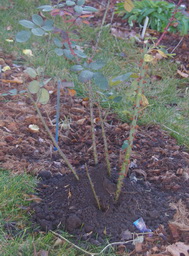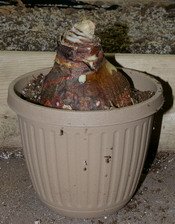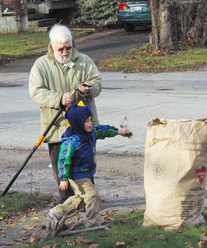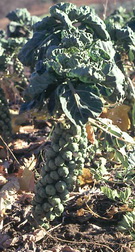


 Amaryllis bulbs are one of my favourite Christmas presents and they have arrived and are now being potted up. Some people, notably my children, get a bulb, a pot and some soil in my desperate attempt to make gardeners out of them; with some success I might add. Many others receive a planted bulb that has started to produce bloom stalks. If you are going to purchase bulbs to grow or to give, do not look at just the price but search the edges of the box to see the size of the bulb. The bigger the bulb the more bloom stalks it will produce. A good average bulb should be 26 - 28 cm in circumference while larger, and therefore more expensive ones, can be 34 - 36 cm. My catalogue shows mammoth bulbs of 42+ cm, which you will only find in specialty shops and they could sell for as much as $30 per bulb. You do get what you pay for but be an educated consumer and check out what it is you are buying.
Amaryllis bulbs are one of my favourite Christmas presents and they have arrived and are now being potted up. Some people, notably my children, get a bulb, a pot and some soil in my desperate attempt to make gardeners out of them; with some success I might add. Many others receive a planted bulb that has started to produce bloom stalks. If you are going to purchase bulbs to grow or to give, do not look at just the price but search the edges of the box to see the size of the bulb. The bigger the bulb the more bloom stalks it will produce. A good average bulb should be 26 - 28 cm in circumference while larger, and therefore more expensive ones, can be 34 - 36 cm. My catalogue shows mammoth bulbs of 42+ cm, which you will only find in specialty shops and they could sell for as much as $30 per bulb. You do get what you pay for but be an educated consumer and check out what it is you are buying.  One of the last outdoor jobs was to prune a few trees. If I was a better garden designer I would only use trees that would not outgrow the location that I planted them in. Sometimes I just want the right look and am prepared to put up with some light pruning to obtain it. The front garden has a delightful Harlequin Maple which is a Norway Maple with bright white variegations on its leaves. It is very attractive and has a special significance to the Assistant Gardener and myself. The local utility company thinks that its power lines should run just where we wanted to locate this specimen and that causes me to prune it, almost every year. I prune it for height and shape, the utility company would prune it to stay clear of their wires without as much consideration for the aesthetics. If the Assistant Gardener isn’t available then enlisting the help of one of the Junior Gardeners can be very useful.
One of the last outdoor jobs was to prune a few trees. If I was a better garden designer I would only use trees that would not outgrow the location that I planted them in. Sometimes I just want the right look and am prepared to put up with some light pruning to obtain it. The front garden has a delightful Harlequin Maple which is a Norway Maple with bright white variegations on its leaves. It is very attractive and has a special significance to the Assistant Gardener and myself. The local utility company thinks that its power lines should run just where we wanted to locate this specimen and that causes me to prune it, almost every year. I prune it for height and shape, the utility company would prune it to stay clear of their wires without as much consideration for the aesthetics. If the Assistant Gardener isn’t available then enlisting the help of one of the Junior Gardeners can be very useful.I spent today at the Royal Botanical Gardens, in Hamilton Ontario, enjoying the company of a local group of garden writers. The RBG is a wonderful institution that is currently undergoing a major transformation. It had a few bleak years and has emerged from that period to be an even more interesting and useful resource for gardeners of all levels. It’s indoor exhibits are pleasant places to spend nasty winter days, including a very pleasant restaurant. Part of our day was a tour of the herbarium. Now you ask, “What could be exciting about a room filled with thousands of dried plant specimens?” The enthusiasm of the young curator was worth the visit but the best part was her answer when she was asked if she would help identify plants for us. She described as, “the best part of her job,” the opportunity to identify any plants sent to her by everyone from amateur gardeners to professional taxonomists. She encouraged us to spread the word that this was a vital and viable part of the RBG’s service to the gardening community that it serves. So go ahead and try and stump her with that unidentified green monster in the back corner of your garden. Of course, the more information about the plant and the more parts of it that you can send to her, the easier it will be for her to satisfy your botanical curiosity.  We were allowed into the Orchid greenhouse, usually off limits to visitors, in order to see a rare treat. Those of you who garden and cook should know that Vanilla is an extract from an Orchid seed pod. Vanilla planifolia is a climbing epiphytic Orchid native to tropical South America and the RBG’s specimen was blooming today. That is a rare treat because each flower only opens for one day and if pollinated will take a few months to mature its seed pod. Each pod contains thousands of tiny seeds and the flavouring is produced from the pod itself rather than the seeds. I have seen several such plants but this was the first time I have seen it bloom and I have captured it here for my readers.
We were allowed into the Orchid greenhouse, usually off limits to visitors, in order to see a rare treat. Those of you who garden and cook should know that Vanilla is an extract from an Orchid seed pod. Vanilla planifolia is a climbing epiphytic Orchid native to tropical South America and the RBG’s specimen was blooming today. That is a rare treat because each flower only opens for one day and if pollinated will take a few months to mature its seed pod. Each pod contains thousands of tiny seeds and the flavouring is produced from the pod itself rather than the seeds. I have seen several such plants but this was the first time I have seen it bloom and I have captured it here for my readers.For those of you who have been following my rapidly growing family, I can brag about the safe arrival of Gabriel our ninth Junior Gardener. I will probably give him his first Amaryllis already potted up. Even if he is my grandson he might not be able to handle potting up bulbs in his first month. Questions My newsletter subscribers get to ask me questions. Just ‘reply’ to the email newsletter. It is always interesting to read the questions; mostly to see if I actually can answer them or if I have to wade into the textbooks to research the answers. If that happens then we all learn something. Soroosh Asks? I remember way back on an issue of Brooklin's Town Crier you talked about planting Saffron in your own backyard. I would like to see if I remembered it correctly.... is it really possible to plant them right here in Brooklin? Also, if so, where can I buy them? (I'm hopeful to find out I can actually produce enough saffron for our own consumption at home... picking the stigmas one by one is a different story). Ken Answers! Yes! Saffron is quite easy to grow even in our part of the world. It is an autumn flowering Crocus Crocus sativus and one of the few that produces leaves as well as it’s flowers in the fall. Just plant the bulbs, (technically corms,)in the late summer and the bright mauve flowers will appear shortly after and will continue to reappear in your garden every fall for several years. That’s the easy part. Saffron is the dried anthers of this flower. Each flower produces three filament-like anthers and you will need to collect several hundred to get an ounce of Saffron. Luckily an ounce of Saffron will go a long way in cooking. Be prepared for a few back breaking hours carefully removing these anthers from the flowers. When you are finished you will have some appreciation for the high cost of this spice. 111 Trent St. W. Whitby ON L1N1L9 |

